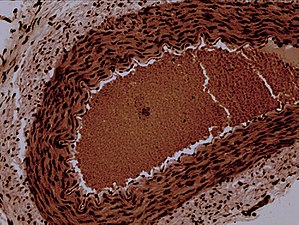Structure and Microanatomy
- Arterioles are small-diameter blood vessels that branch out from arteries and lead to capillaries.
- They have muscular walls, usually consisting of one to two layers of smooth muscle cells.
- The endothelium lines all blood-contacting surfaces, including arterioles.
- Nitric oxide production by the endothelium promotes a healthy vascular system.
- Gap junctions allow direct electrical and chemical communication between endothelial cells and vascular smooth muscle.
- The endothelium requires a complex balance of polyphenols, nitric oxide synthase enzymes, and L-arginine for nitric oxide production.
- The vascular smooth muscle of arterioles receives autonomic nervous system innervation and responds to circulating hormones.
Physiology
- Arterioles are the primary site of vascular resistance.
- The transition from arterioles to capillaries causes the greatest change in blood pressure and velocity of blood flow.
- Arterioles decrease the pressure to prevent capillaries from exploding.
- Blood pressure in the arteries is a result of the work needed to pump the cardiac output through the vascular resistance.
- Arterioles play a crucial role in regulating blood pressure and flow.
- The velocity of flow in capillaries affects blood pressure due to Bernoulli's principle.
- Arterioles undergo autoregulation to maintain sufficient blood flow despite changes in pressure.
- Various hormones and factors influence arteriole tone and diameter.
Clinical significance
- Arteriole diameters decrease with age and exposure to air pollution.
- Constriction of arterioles increases total peripheral resistance and can lead to hypertension.
- Arteriolosclerosis refers to the hardening of arteriole walls, often associated with aging or pathological conditions.
- Arteritis of arterioles occurs when the walls become inflamed due to infection or autoimmune response.
- Medications that target arteriole contraction can be used to lower blood pressure.
Metarterioles
- Metarterioles are arterioles that bypass capillary circulation.
- They play a role in regulating blood flow and distribution.
- Metarterioles have a structure that allows for the direct exchange of substances between arterioles and venules.
- They can regulate blood flow to specific tissues or organs.
- Metarterioles contribute to the control of blood pressure and flow in the microcirculation.
Notable facts and statistics
- The transition from arterioles to capillaries causes the greatest change in blood pressure and velocity of blood flow.
- Arteriole diameters decrease with age and exposure to air pollution.
- Constriction of arterioles increases total peripheral resistance and can lead to hypertension.
- Arteriolosclerosis refers to the hardening of arteriole walls, often associated with aging or pathological conditions.
- Arteritis of arterioles occurs when the walls become inflamed due to infection or autoimmune response.
An arteriole is a small-diameter blood vessel in the microcirculation that extends and branches out from an artery and leads to capillaries.
| Arteriole | |
|---|---|
 Types of blood vessels, including an arteriole and artery, as well as capillaries. | |
 Rabbit arteriole at 100X | |
| Details | |
| Pronunciation | /ɑːrˈtɪəri.oʊl/ |
| Identifiers | |
| Latin | arteriola |
| MeSH | D001160 |
| TA98 | A12.0.00.005 |
| TA2 | 3900 |
| FMA | 63182 |
| Anatomical terminology | |
Arterioles have muscular walls (usually only one to two layers of smooth muscle cells) and are the primary site of vascular resistance. The greatest change in blood pressure and velocity of blood flow occurs at the transition of arterioles to capillaries. This function is extremely important because it prevents the thin, one-layer capillaries from exploding upon pressure. The arterioles achieve this decrease in pressure, as they are the site with the highest resistance (a large contributor to total peripheral resistance) which translates to a large decrease in the pressure.